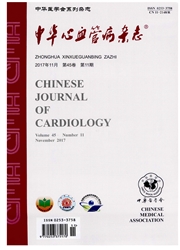

 中文摘要:
中文摘要:
目的 探讨抗心律失常肽(antiarrhythmic petide 10,AAP10)和溶血磷脂酸(lysophosphatidic acid,LPA)对兔室性心律失常的影响及其作用机制.方法 24只新西兰大白兔随机分为正常对照组、LPA组和AAP10干预组,建立兔左心室楔形心肌块模型,同步记录楔形心肌块内、外膜心肌细胞动作电位和跨室壁心电图,程序电刺激起搏,记录室性心律失常发生率.通过免疫印迹技术(Western blot)检测三组心肌去磷酸化缝隙连接蛋白43(non-phosphorylated connexin 43,NPCx43)的变化,采用免疫荧光技术观察NP-Cx43的分布.结果 LPA组QT间期、动作电位复极90%时程(90%of duration of action potential,APD90)、跨室壁复极离散度(transmural repolarization dispersion,TDR)与对照组相比均明显增加(P<0.01),同时多形性室性心动过速的诱发率也明显增加(62.5%比0,P<0.01),并伴随NP-Cx43含量明显增加(P<0.01);AAP10干预组与LPA组相比,QT间期、内膜APD90、TDR均明显缩小(P<0.01),多形性室性心动过速的诱发率也明显降低(P<0.05),NP-Cx43含量也明显下降(P<0.01).三组之间总Cx43含量差异无统计学意义.结论LPA有明显致心律失常作用,其机制可能与引起NP-Gx43含量增加、抑制缝隙连接通道功能有关,而AAP10可以拮抗LPA引起的NP-Cx43含量增加,同时降低LPA所致室性心律失常的发生率,具有抗心律失常的保护作用.
 英文摘要:
英文摘要:
Objective To investigate the effect and potential mechanism of lysophosphatidic acid (LPA) and antiarrhythmic peptide (AAP10) on rabbit ventricular arrhythmia. Methods Twenty-four rabbits were randomly divided into three groups (n =8 each): control group, LPA group and AAP10 + LPA group. Using arterially perfused rabbit ventricular wedge preparations, transmural ECG and action potentials from both endocardium and epicardium were simultaneously recorded in the whole process of all experiments with two separate floating microeletrodes. The incidence of ventricular arrhythmia post S1S2 stimulation was recorded. Protein levels of nonphosphorylated Cx43 and total Cx43 were evaluated by Western blot. The distribution of nonphosphorylated Cx43 was observed by confocal immunofluorescence microscopy. Results Compared with the control group, the QT interval, endocardial action potential duration, transmural repolarization dispersion (TDR) and incidence of ventricular arrhythmia were significantly increased and nonphosphorylated Cx43 expression was significantly upregulated in the LPA group. Compared with the LPA group, cotreatment with AAP10 can reduce the QT interval, endocardial action potential duration, TDR and incidence of ventricular arrhythmia (25.0% vs 62. 5%, P 〈 0. 01 ) and downregulate nonphosphorylated Cx43. Conclusions LPA could promote the arrhythmia possibly by upregulating nonphosphorylated Cx43 and subsequent gap junction transmission inhibition. Gap junction enhancer AAP10 could attenuate the proarrhythmic effect of LPA probably by downregulating myocardial nonphosphorylated Cx43 expression.
 同期刊论文项目
同期刊论文项目
 同项目期刊论文
同项目期刊论文
 Gap junctions enhancer combined with Vaughan Williams class III antiarrhythmic drugs, a promising an
Gap junctions enhancer combined with Vaughan Williams class III antiarrhythmic drugs, a promising an Pharmacological Enhancement of Cardiac Gap Junction Coupling Prevents Arrhythmias in Canine LQT2 Mod
Pharmacological Enhancement of Cardiac Gap Junction Coupling Prevents Arrhythmias in Canine LQT2 Mod 期刊信息
期刊信息
